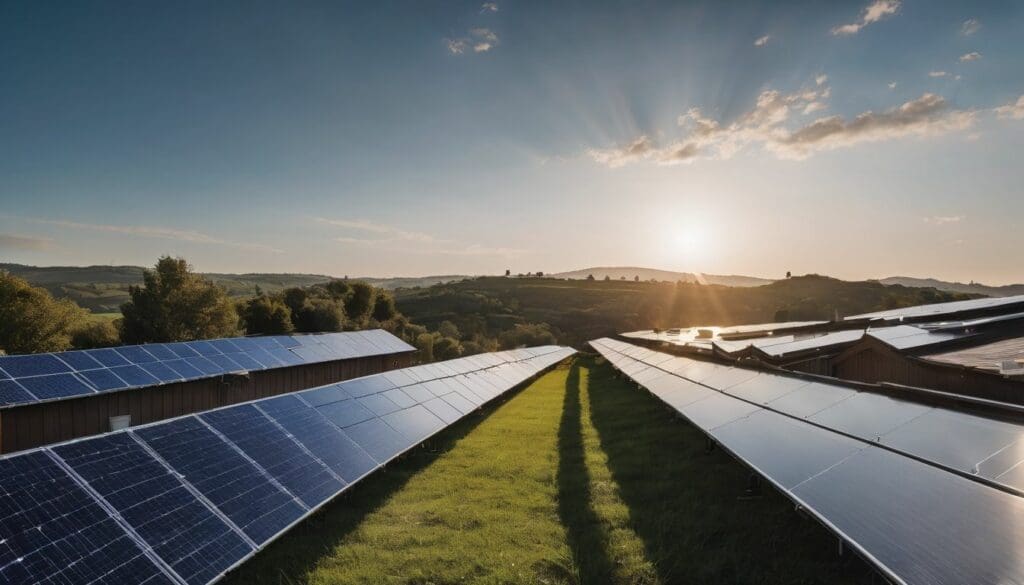Are you tired of paying high electricity bills? Did you know that solar energy is a renewable and sustainable source of power for your home? In this article, we will explore the basics of solar powered home systems and how they can benefit you. Stay tuned to discover how you can save money and reduce your carbon footprint by harnessing the power of the sun.
Key Takeaways
- Solar energy is a clean and renewable source that can significantly reduce electricity bills, boost home value, provide energy independence, and contribute to environmental conservation.
- Key components of a solar powered home system include photovoltaic panels or PV panels, inverters for converting DC to usable AC power, batteries for energy storage and solar controllers which manage the flow of electricity.
- The size and efficiency of the solar system should match your household’s energy needs; it’s important to calculate potential energy production based on sunlight availability and monitor consumption patterns for optimal sizing. Net metering can offer financial benefits by allowing surplus power sales back to the grid.
- There are various financing options available including solar loans, leases, Power Purchase Agreements (PPAs), government incentives like tax credits, Feed-In Tariffs (FITs), Renewable Energy Certificates (RECs) making sustainable investment more affordable.
- Proper installation whether DIY or professional impacts long – term system efficiency; regular maintenance is required including panel cleaning and performance monitoring to ensure smooth operation.
What is solar energy
Solar energy harnesses the power of the sun’s rays to generate electricity or heat. It is a type of renewable energy that comes from an abundant and sustainable source, making it a clean alternative to fossil fuels.
Photovoltaic technology allows solar panels to convert sunlight directly into electrical power for use in homes and businesses.
A home solar electric system consists of several key components including solar panels, an inverter, batteries for storage, and often a solar controller. These work together to collect energy from the sun during daylight hours, converting it into usable electricity that can reduce reliance on traditional power grids.
Solar power equipment empowers individuals aiming for sustainable living with control over their own clean energy production.
Benefits of using solar power in your home
Harnessing solar energy goes beyond understanding its basics; it brings tangible benefits to your household. Transitioning to a solar powered home system offers numerous advantages, both environmentally and financially.
- Slashes electric bills: You’ll see a major drop in your monthly electricity costs since solar panels generate power from the sun’s energy, which is free.
- Boosts home value: Homes with solar power systems are often valued higher, attracting buyers interested in sustainability and lower utility costs.
- Provides energy independence: With a solar setup, you depend less on traditional energy sources, safeguarding against fluctuating utility prices and supply disruptions.
- Contributes to a cleaner environment: Solar electricity is green technology that reduces carbon footprint by not emitting harmful pollutants.
- Offers financial incentives: Governments frequently offer tax credits and solar incentives, making the initial cost of installation more manageable.
- Ensures reliable power supply: Photovoltaic systems can be paired with batteries for energy storage, providing uninterrupted power even during outages.
- Encourages sustainable living: Using renewable energy aligns with conservation efforts, supporting environmental protection and reducing reliance on non-renewable resources.
- Lowers maintenance costs: Solar power systems require minimal upkeep compared to traditional energy sources, leading to further savings over time.
- Increases self-sufficiency: For those considering off-grid living or wanting greater control over their own utilities, these systems offer a viable solution.
- Harnesses unlimited resource potential: The sun provides a vast amount of clean energy daily; tapping into this unlimited resource maximises your home’s solar potential.
Components of a Solar Powered Home System
Solar panels, inverters, batteries, and solar controllers are the key components of a solar powered home system. Find out how these work together to power your home sustainably. Read on to learn more about setting up your own solar powered home system.
Solar panels
Solar panels are crucial components of a solar power system. These panels absorb sunlight and convert it into electricity, making them an essential part of harnessing solar energy for your home.
When choosing solar panels, consider factors such as the panel’s efficiency, durability, and warranty to ensure you get the most out of your investment.
When considering solar panels for your home, it’s important to take into account their location on your property and the angle at which they are installed. This will maximise their exposure to sunlight and enhance your system’s overall performance.
Properly installed and maintained solar panels can significantly reduce your carbon footprint and energy bills while providing a reliable source of clean energy for years to come.
Inverters
Inverters play a crucial role in converting the direct current (DC) electricity produced by solar panels into alternating current (AC) electricity, which is what most household appliances use.
By doing this, inverters ensure that the power generated from solar panels can be used to run lights, electronics, and other devices in your home. There are different types of inverters to choose from, including string inverters, microinverters, and power optimisers.
Each has its own advantages and considerations when it comes to efficiency and installation.
Batteries
Solar batteries are an essential component of a solar-powered home system. These batteries store the electricity generated by your solar panels, allowing you to use it even when the sun isn’t shining.
With advances in technology, modern solar batteries are more efficient and longer-lasting, making them an excellent choice for environmentally conscious individuals looking to reduce their reliance on the grid.
When selecting a solar battery, consider factors such as capacity, depth of discharge, round-trip efficiency, and warranty. It’s crucial to choose a battery that aligns with your energy storage needs and complements your overall home system.
Solar controllers
When it comes to managing the flow of energy within your solar powered home system, solar controllers play a vital role. Utilising intelligent algorithms and sensors, these devices regulate the voltage and current from the solar panels to ensure efficient charging and discharging of the batteries.
Additionally, they protect the batteries from overcharging or deep discharge, ultimately prolonging their lifespan. With advanced technology, modern solar controllers are capable of optimising power output by adjusting to changing weather conditions, thus maximising energy production for your home.
To further maximise efficiency in your solar powered home system, considering the capabilities and features of different types of solar controllers is essential. By selecting a controller that suits your specific needs and environment, you can ensure that your system operates at its peak potential while contributing towards conservation and environmental sustainability.
Sizing and Efficiency
Choosing the right size solar system for your home is crucial. Calculating efficiency and considering net metering can help you make the most of your solar power.
Choosing the right size for your home
Selecting the correct size for your home’s solar system is crucial for maximising energy production. Consider factors such as your average electricity usage, available roof space, and local weather conditions.
It’s essential to conduct a thorough energy audit to determine the optimal size of the solar power system that suits your household needs.
Ensure that you engage with a certified solar professional who can help assess your energy requirements accurately. They will evaluate various aspects, including the orientation and tilt of your roof, shading from nearby trees or buildings, and daily sunlight exposure levels in your area.
Calculating efficiency
When considering the efficiency of a solar powered home system, it is important to:
- Assess the amount of sunlight your location receives to determine potential energy production.
- Evaluate the efficiency rating of solar panels to understand how effectively they convert sunlight into electricity.
- Consider the angle and orientation of solar panels for optimal sunlight absorption.
- Monitor energy consumption patterns in your home to size the solar power system appropriately.
Net metering
Net metering allows you to sell excess solar power back to the grid, offsetting your energy costs. When your system generates more electricity than you use, the surplus goes back into the grid, and you receive credits on your electricity bill.
This means that during sunny months or peak production times, you can benefit from lower energy costs by essentially getting paid for the excess energy your system produces.
Using net metering not only helps reduce your utility bills but also contributes to a more sustainable and efficient electrical grid. By taking advantage of this program, homeowners can actively participate in promoting renewable energy while enjoying financial benefits.
Financing and Incentives
Explore available financing options and solar incentives and tax credits to make the switch to solar power a more affordable and rewarding investment. Read on to learn how you can save money while harnessing the power of the sun for your home.
Available financing options
You can explore various financing options when installing a solar powered home system. Consider the following:
- Solar loans: Many financial institutions offer loans specifically for solar installation, with competitive interest rates and flexible repayment terms.
- Home equity loans or lines of credit: Utilise the equity in your home to finance the upfront costs of a solar system installation.
- Power purchase agreements (PPAs): Enter into an agreement with a solar provider to have a system installed on your property without any upfront costs, paying only for the energy produced.
- Solar leases: Lease a solar system from a company, avoiding initial costs and benefiting from lower monthly electricity bills.
- Government grants and incentives: Check for available grants, rebates, and tax credits provided by local or national governments to support renewable energy investments.
- Property Assessed Clean Energy (PACE) financing: Some regions offer PACE programmes allowing homeowners to finance renewable energy projects through property assessments.
Solar incentives and tax credits
Solar incentives and tax credits can significantly reduce the initial cost of installing a solar powered home system. Government incentives such as Feed-In Tariffs and Renewable Energy Certificates stimulate the uptake of solar energy. These incentives offer financial returns for surplus energy fed back into the grid, effectively reducing your electricity bills.
- Feed-In Tariffs: This scheme allows homeowners to earn money by selling excess electricity generated by their solar panels back to the grid.
- Renewable Energy Certificates (RECs): Homeowners can earn RECs for every megawatt-hour of clean electricity generated from their solar panels. These RECs can then be sold or traded, providing additional financial benefits.
- Tax Credits: By taking advantage of federal tax incentives and local rebates, you can offset a percentage of your installation costs come tax season.
- Solar Loan Programs: Many governments offer low-interest loans for homeowners interested in installing solar systems, making it easier to finance the upfront costs.
Installation and Maintenance
Consider the cost and options for installation, whether DIY or hiring a professional, as well as the necessary maintenance for a solar system. Discover more about maximising the efficiency of your solar powered home system by reading on.
Cost and options for installation
- Professional installation involves hiring certified solar installers for a seamless process. They handle permits, installation, and connecting the system to the grid.
- DIY options require purchasing solar panel kits or individual components. This option saves on labour costs but needs understanding of electrical work and building codes.
- Roof – mounted systems are common for residential installations due to space efficiency and unobstructed sun exposure.
- Ground – mounted systems offer flexibility and easy maintenance but may incur additional costs for land preparation.
- Hybrid systems integrate solar with other energy sources such as wind or generators, providing backup during low sunlight periods.
- Leasing solar panels allows homeowners to avoid upfront investment by paying a monthly fee, often including maintenance services.
DIY or hiring a professional
Solar power offers independence, but when it comes to installation, making the right choice between DIY and hiring a professional is crucial.
| DIY Installation | Professional Installation |
|---|---|
| Costs less initially, appealing for hand-on individuals. | More expensive due to labour, but usually includes warranties. |
| You must acquire all necessary permits and approvals. | The professional service typically handles permits and paperwork. |
| Demands a solid understanding of electrical systems and safety measures. | Expertise ensures safe and optimal system setup. |
| Responsibility for troubleshooting and repairs rests on you. | After-sales support and maintenance are often part of the service package. |
| Potential for errors which could affect system efficiency. | Higher likelihood of a correctly installed, efficient system. |
| Satisfaction from completing a personal project. | Convenience as the company manages the entire process. |
Necessary maintenance for a solar system
After considering the installation of your solar system, it’s important to keep it running smoothly. Here are some key maintenance factors:
- Regular Cleaning: Keep the solar panels clean from dust and debris to maintain efficiency.
- Inspect for Damage: Regularly check for any physical damage or wear and tear on the panels, wiring, and other components.
- Monitoring Performance: Keep an eye on the performance of the system and address any drop in output promptly.
- Professional Inspections: Schedule periodic professional inspections to ensure all components are functioning optimally.
- Battery Maintenance: If you have a battery backup system, ensure proper maintenance as per manufacturer’s guidelines.
- Software Updates: Stay updated with software upgrades for inverters or monitoring systems to optimise performance.
- End-of-Warranty Review: As warranties expire, review and consider potential component replacements or upgrades.
- Weather Preparedness: Take necessary precautions during extreme weather conditions to protect your solar power system.
Tips for Solar Efficiency
Maximise the efficiency of your solar system by choosing the right mounting options for your panels and selecting the most suitable type of panels for your location and weather conditions.
Consider how solar energy can impact the value of your home and its insurance coverage.
Mounting options for solar panels
When considering mounting options for solar panels, it’s crucial to assess the available space and exposure to sunlight. Roof-mounted panels are a popular choice, maximising space efficiency and minimising visual impact.
Ground-mounted systems offer flexibility in installation and maintenance access.
Another option is pole mounts which can be adjusted for optimal sun exposure throughout the day. Tracking mounts automatically follow the sun’s path, maximising energy production. Each mounting option has its own benefits and considerations – ensuring proper positioning will enhance overall system performance.
Types of solar panels
Solar panels come in various types, including monocrystalline, polycrystalline, and thin-film. Monocrystalline panels are more space-efficient and offer higher efficiency rates. Polycrystalline panels are cost-effective and have a lower efficiency compared to monocrystalline options.
Thin-film panels are lightweight and flexible, making them suitable for certain installations where traditional rigid solar panels may not be ideal.
Understanding the different types of solar panels is crucial when considering a home solar system. Each type has its unique advantages and considerations that can impact the overall performance of your solar energy system.
Importance of location and weather
Proper placement of solar panels is crucial for maximum energy production. The amount of sunlight a panel receives is directly impacted by its location and the prevailing weather conditions.
Panels should ideally be installed where they can capture the most sunlight throughout the day, with minimal shading from nearby trees or buildings. Additionally, regions with more sunshine will generally produce more solar energy, making understanding local weather patterns vital when considering a solar-powered home system.
Understanding these factors ensures that your investment in solar power will yield optimal results. For those dedicated to maximising their use of renewable energy sources while minimising environmental impact, such considerations are essential for achieving true sustainability.
Impact on home value and insurance
Installing a solar power system can significantly boost the value of your home. Studies have shown that homes with solar panels tend to sell for more than those without. Furthermore, having a sustainable energy solution like solar power could also lower your homeowner’s insurance premiums, as it reduces the risk of electrical fires and other related hazards.
When considering the impact on home value and insurance, it’s important to consult with a qualified appraiser or real estate agent who has experience in valuing properties with solar installations.
They can provide insight into how much value solar panels could add to your specific property and advise on potential adjustments you may need to make to your insurance coverage after installing a solar power system.
Conclusion
In conclusion, understanding the basics of solar powered home systems is essential for environmentally conscious individuals. Solar energy provides numerous benefits and can be an effective way to support conservation efforts.
By learning about the components, sizing, efficiency, financing options, installation, maintenance, and tips for solar efficiency, homeowners can make informed decisions about integrating solar power into their homes.
With this knowledge in hand, they can harness the power of the sun to reduce their carbon footprint while enjoying long-term cost savings.
FAQs
1. What are solar powered home systems?
Solar powered home systems use panels to capture sunlight and convert it into electricity for your house, helping you cut energy costs and reduce reliance on traditional power sources.
2. Can I use solar energy if I live off the grid?
Absolutely! Off-grid systems provide a great solution for homes located away from central power lines, as they can independently generate and store energy from the sun.
3. Do solar home systems work at night or on cloudy days?
While they primarily gather energy during sunny periods, solar home systems often come with batteries that store extra power, ensuring your home still has electricity when there’s no sunlight.
4. Is maintaining a solar powered system difficult?
Not really! Solar powered systems typically require minimal maintenance; just keep the panels clean and check connections occasionally to ensure everything works smoothly.





